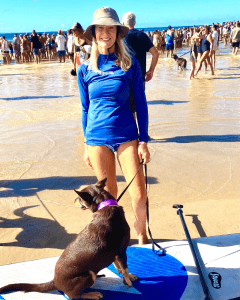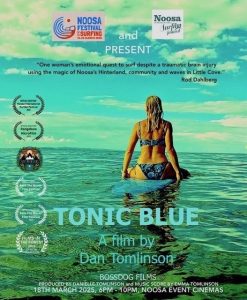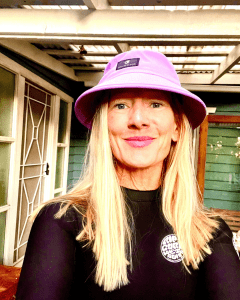Danielle’s journey
In 2014, Danielle’s life changed in an instant. A fall beside a swimming pool while on holiday in Vanuatu left her with multiple skull fractures, a cerebral haemorrhage and a CSF leak. “I wasn’t managed properly,” she says. “But my daughter, just 14 at the time, saved my life. I wouldn’t be here without her.” Months later, as swelling subsided, the full impact revealed itself: damaged neural pathways and, eventually, tonic-clonic epilepsy. “I’m a screenwriter, filmmaker, nurse, surfer… and brain injury survivor,” says Danielle, 53, from Cooran, a small artistic village in Noosa’s hinterland.

Rewiring hope
With a background in perioperative nursing, Danielle understood enough neuroscience to search for a way forward. “I created my own neuro-rehab exercises using brain plasticity known in neurological terms as, “neuroplasticity”. It wasn’t perfect and at times was exhausting, especially when it interfered with running the house, but I knew the brain could rewire and this became my focus.”
She began deliberately activating her less dominant side, left foot, left hand, pairing movement with speech, comprehension and creative tasks while also counting or driving each force to a beat. The practice unlocked something unexpected. “I’m neurodiverse, with a tendency to become hyper focused and in this case, it was an asset as the exercises triggered synaesthesia. I began seeing colour (translucent ribbons of electric blue) when I heard perfect vocal pitch affiliated with Bel canto opera (sung by her daughter), a cacophony of cicadas at dusk and when waves tapped a glassy ocean surface unaltered by elements. My perception shifted; it was like I could feel the brain clicking back on from black and white static to rainbow colours.”
When the ocean became medicine
Cleared to return to activities conditionally, Danielle found herself drawn back to the sea. “Surfing became part of my rehab. Paddling through the breakers and finally reaching the line-up told me I’d defied the odds.”
Safety comes first: she wears a soft helmet and a medical alert bracelet, surfs small waves with a small crew, and never goes out alone. She also ‘wears purple on purpose’, a purple leg rope, fins, wax and purple tagged board bag supported by surfing merchandise companies ‘Creatures of Leisures and Future Fins’. This is so beachgoers and other surfers get a visual cue that she may need space, time or a hand. “If little signals help the public recognise invisible disabilities, then I’ve achieved my goal. It’s taking accountability and agency, owning the conditions that let me participate safely.”
Her advocacy has grown alongside her surf practice. “I’ve met other surfers with brain injuries or epilepsy. I am now a committee member of Noosa’s World Surfing Reserve, and we are working on a more detailed surfers code that includes the importance of surfing etiquette. Along with promoting respect in the line up to improve safety and better signage we’re exploring a simple idea: visible signals for invisible disabilities. It could be a colour, a wristband, a set of ‘surf etiquette’ prompts at events, practical touches that let more of us get back to the water while also only surfing at certain spots based on ability.”
A creative brain switched back on
As her rehab deepened, a rush of stories arrived most linked to the community of Cooran. “Walking in the bush accompanied by my dogs and an orphaned magpie, I’d see scenes projecting into the canopy.” She shares, “I wrote a treatment, then a feature script ‘Stone Face’ with guidance from local Indigenous Elders. That took me to Screen Qld Mob and to the New York Film Academy in 2022 via Zoom from my veranda where I completed a Diploma in Screenwriting and Film Media then a Certificate in Directing from AFTRS Australian Film Television Radio School.”
In parallel, Danielle co-produced a musical theatre production, Opera Funk, with her daughter for Noosa Alive (2019), exhibited in Cooran’s Tall Trees since 2017 (now an Honorary Life Member), received the Queensland Day Arts Award (2023), and was named the Noosa World Surfing Reserve People’s Choice Award winner for using film to champion ocean conservation and the awareness of surfing etiquette.
But her most personal work is a short film called ‘Tonic Blue’. “It’s about returning to the ocean, how surfing, done safely and with support, became part of my rehab despite epilepsy. ‘Tonic’ as medicine. ‘Tonic-clonic’ for seizures. And the tonic of blue water. Blue also connected to the transient colours of water and our ocean but also connected to my synaesthesia.”
“I’m not saying grab your board and go surfing. I’m simply saying if you are medically cleared to swim and enjoy surfing or any water sport then it is up to you to take agency and be accountable.”
The film premiered this year at Noosa’s Festival of Surfing in collaboration with the Noosa International Surf Film Festival at Noosa’s Event Cinemas. Danielle was guest panellist alongside other surfers with invisible injuries who got to share their stories and the importance of respecting surfing etiquette. The film has since been officially selected to screen at various festivals around Queensland and internationally resulting with being in the running for next year’s ACTAS best short documentary based upon votes. This includes her daughter Emma’s song ‘Consequences’ as best original music score. Danielle continues to develop adaptive-surfing content and etiquette resources with local communities.
Advocacy, inclusion and a bigger conversation
Danielle is frank about the gaps she encountered after leaving hospital. “I wasn’t told about Synapse. No one talked to me about neuroplasticity. It felt like a one-size-fits-all model: speech, occupational therapy, physio, and then good luck. The current allied health system being utilised is extremely basic and brain injury rehabilitation units need to start incorporating the fields of neuroscience. The outpatient brain injury units could utilise students studying neuropsychology, neurology, sports-medicine, exercise science, medicine and nursing which would assist with patient workload while also improving their professional understanding of integrated allied health and provide practical placement.”
She wants more integrated information at discharge, clearer pathways to community support and the importance of practical inclusion across the arts and sport which could potentially reduce anxiety and feelings of isolation.
She is now a member of Noosa’s World Surfing Reserve Committee in Noosa, Australia. This location was officially designated as the 10th World Surfing Reserve due to its remarkable waves, surf zones, and a community dedicated to safeguarding its coastal and surfing heritage. Alongside others, she aims to promote the significance of surfing etiquette and respect for the Surfers Code.
She also represents the Screen Inclusion and Diversity Network, advocating for adaptive work practices on set, shorter days, roster flexibility, supportive crews, and uses public speaking to connect policymakers with lived experience. “Change happens when the right people can picture what inclusion looks like in the real world.”

The rituals that drive and hold through the adversity of brain injury
Life today is equal parts creative work and careful routine which aligns with being a tertiary educated scientist, artist and environmentalist. “Activities of daily living that uniquely solder my scaffolding: write, film, garden, walk, surf, build rest. That rhythm protects energy and memory.” She’s candid about fatigue and speech mix-ups, effects of scar tissue that mimic frontotemporal dementia on scans. “When fatigued, I tend to lose words, mix up vowels or consonants and have to circle back. It’s confronting, but it’s part of it.”
Most of all, she’s grateful for the community of Cooran and Noosa including its First Nation community and local screen collective. Her daughter, son and husband, local arts scene, surf coaches and mates, the region’s indigenous elders and the organisations that have opened doors. Moving forward isn’t just about heading in a straight line, it’s creatively thinking of ways to achieve your goal. “Inclusion isn’t abstract. It’s a person saying, ‘How can we make this work for you?”

Danielle-Supported-by-Creatures-of-Leisure-Futures-Fins
Danielle’s advice
- “Ask questions about neuroplasticity and adaptive technology. Your brain has the ability to rewire and those extra plastic exercises may be the catalyst that provides a new lease of life. Establishing confidence and belief that there is a way forward.”
- Surf/participate conditionally. “Listen to red flags; safety first. I wear a helmet and medical ID and keep to gentle conditions.”
- Build routine. “Rituals, ADLs, protect your energy and help memory.”
- Seek inclusion. “Let your community support you. Mine did, and it changed everything.”
Life now is about balance, writing, surfing, gardening, resting. Some days are harder than others, but Danielle keeps showing up for herself and her community. She knows recovery isn’t about perfection, it’s about finding what works and holding onto it. The goal now is to complete her feature film ‘Stone Face’ and provide opportunities for the individuals who have backed and encouraged her every step of the way.